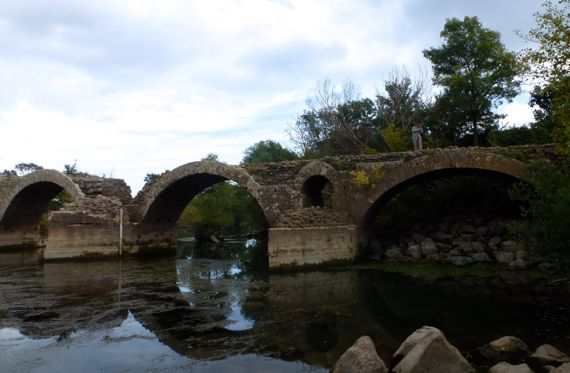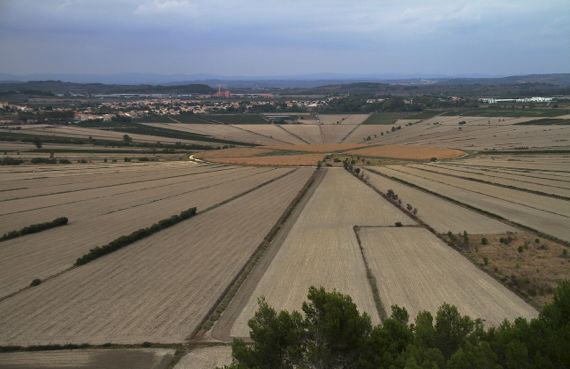Musings

Sometimes when you’re traveling (or amidst life), you have to let serendipity prevail. We made a side loop to visit…Cadillac. Because it was there.
And discovered it’s a walled town, with some plain but impressive ramparts (if, indeed, that’s what they are).
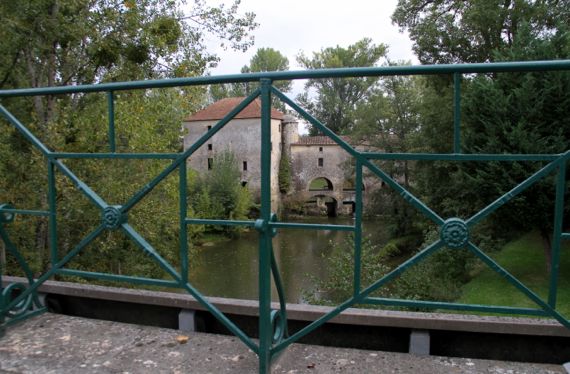
Then we took another side loop to check out a cultural feature signposted as “Pont Eiffel.” There was no pullout nearby, and no way to see the lacy metal support structure of the small (like three car-lengths) bridge in any detail, and we can only guess that the tour-Eiffel engineer had a hand in this one instead of merely influencing it. So, no bridge pix—only this one of the mill just upstream (no public access). Moral of this story: serendipity is sometimes just for your eyeballs—and imagination—and not for your camera.
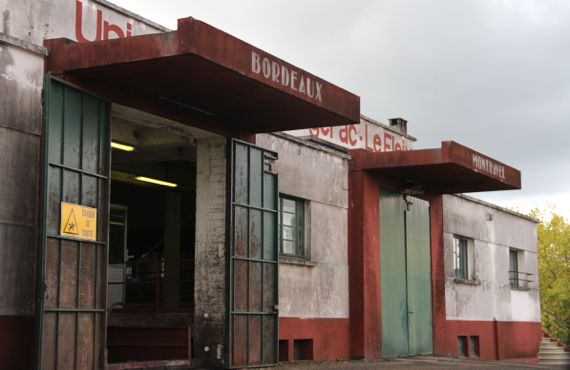
Sometime later, we passed through an area where the grape-harvest was well underway. The trucks from the fields apparently back up to the gate appropriate to the variety they are carrying. The smell of souring grape-juice and the busy insects were the most dramatic impressions/activity at the moment we encountered this cooperative.
We covered some territory today, and the agricultural crops and general landscape went through several noticeable changes as we left the coast and moved through inland zones. We are overnighting in Perigord, and it is nut/fruit country—no grain and olives are long behind us, as are the chateaux of Bordeaux.
We’re staying in a really small town—the only biz is our B&B—with several homes and a church getting major attention from historic preservationists. The cracks in the walls are being monitored as restoration continues, using these simple calibrated slips.
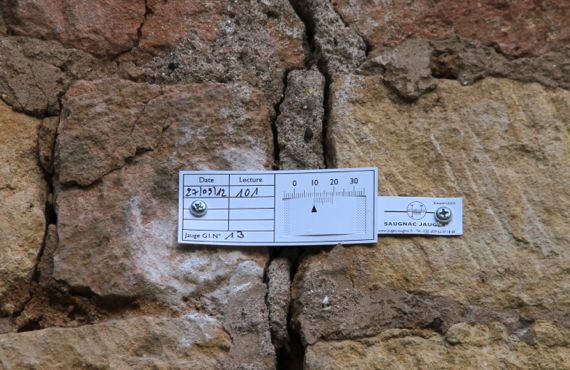
Posted at 10:22 PM |
Comments Off on The changes we are seeing

Descending from the heights, like many people through history, our first stop was Saint-Jean-Pied-de-Port. Its medieval section is basically one main street, with perpendicular side streets (it’s not a hilltop town), adjacent to a river with a gorgeous little bridge. We saw school-bound kids crossing, stopping, as children will, to look in the water.
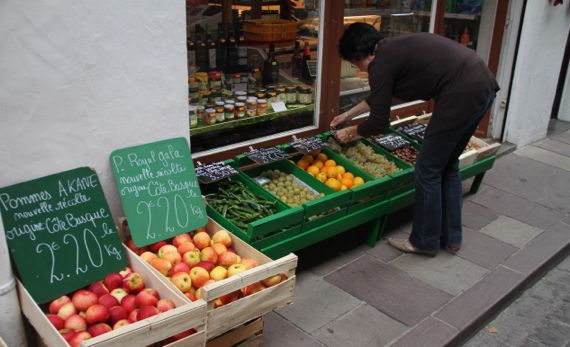
We were there early, and saw many shopkeepers opening for the day. You can tell that, although many shops catered to the tourists, people also live here—not many tourists buy apples by the kilo….
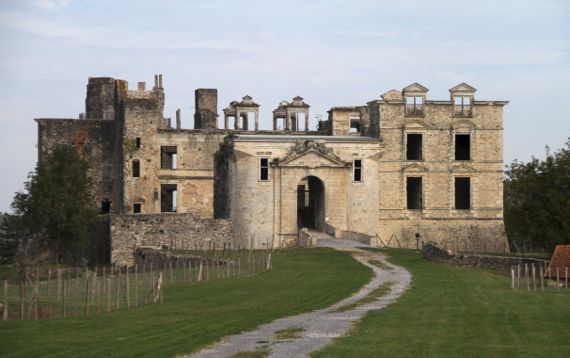
We detoured to Bidache to check out this ruined chateau. Without an appointment, we could only walk up to the front, but that by itself was pretty darned spectacular. We both found the tops of the stone window frames standing tall without their intended wall/roof partner-elements visually compelling.

How can this be last? Still, it was chronologically.
When we stood on the beach in the late afternoon, watching the surfing crowd trickle in (we theorized: after their day jobs), we knew we’d made tracks this day—from dawn in the Spanish Pyrenees to marine layer, late-day light on the Atlantic. What a great world.
Posted at 10:22 PM |
2 Comments »
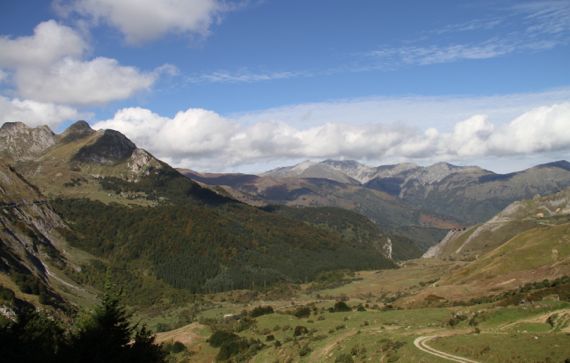
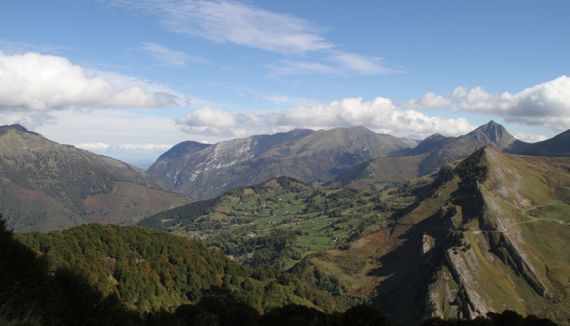
Sweeping views. Green vegetation just beginning to turn autumnal colors. High-elevation cattle. Hard-pedaling bicyclists.
The French side of the Pyrenees.
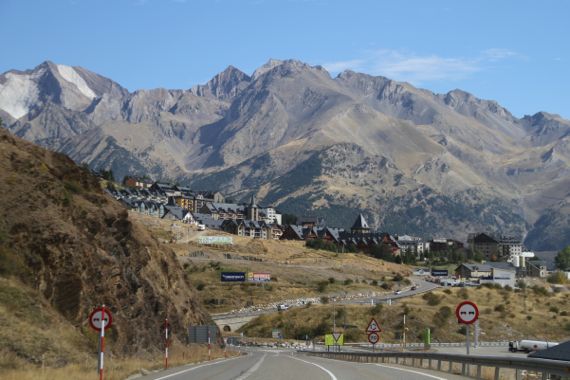
The Spanish side—our route, at least.
Less vegetation, so drier. One major ski town instead of several.
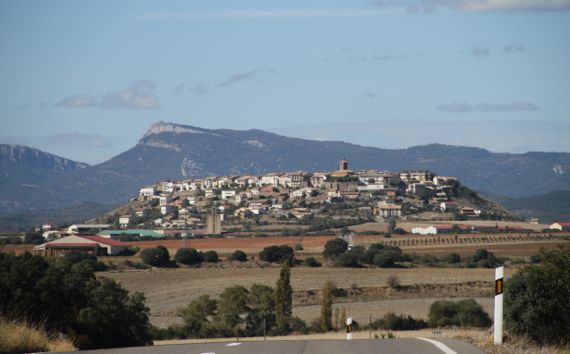
Then we dropped down onto a plateau with very red-orange soils. Where erosion had cut into the surface, the deeper soils were grey-white, and apparently not arable.
Gorgeous skies everywhere. Not sure when I checked that box….
Posted at 10:22 PM |
Comments Off on Pyrenees, two flavors

That’s Basque on the right….
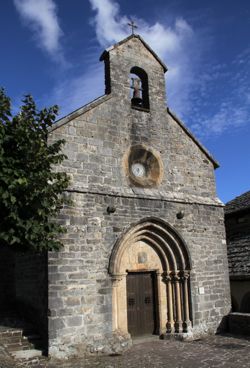
Way back in 778, soldiers fought. That part is agreed upon.
The where: generally, a pass in the Pyrenees.
And there’s certainly a bottleneck in the landscape that could spell trouble for an army.
The leader of the besieged northbound forces: Charlemagne, Carlos Magnus—his names vary….
Beyond that, we have multiple interpretations.
On top of that, many modern visitors are religious pilgrims, bound for Santiago de Compostela, hundreds of kilometers to the west. This church is in Roncesvalles, which isn’t really a town, but several hotels, the church, and a community building of some kind (museum?).
The community of Valcarlos, farther north, is well into Basque country, and claim the worst of the massacre happened there. We have a lovely room beneath the roof, in a hotel otherwise empty except for the owner-family. This valley is part of modern Spain, and the territory “pokes up” into France. The next valley west is French, and similarly “pokes down” into Spain. All are Basque, part of Navarre Basse.
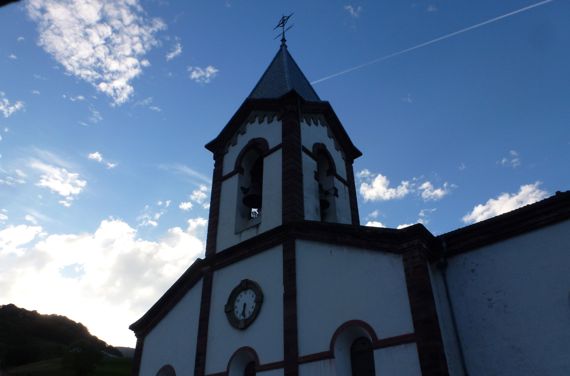
Through our skylight, we had a great view of the Valcarlos church tower. And could hear the sound of the bells. In great detail and loudness. Fortunately, they stopped their hourly chiming with the 9PM “concert.”

The view east from our room, if you crane your neck, is of this green green slope, with scattered farm buildings and white “cow dots”—just gorgeous. Our cartographic information indicates that the international border is at the crest of this hill.
Posted at 10:22 AM |
Comments Off on Shrouded in history in the Pyrenees
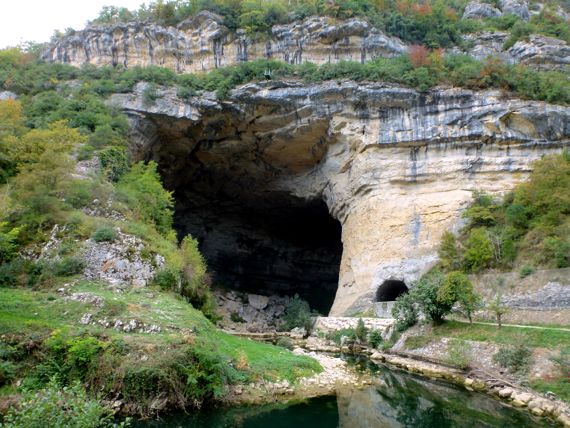
We drove into a cave. We drove in a cave. We exited a tunnel, just to the right of this, the south or southwest mouth of Le Mas d’Azil cave/grotte. Pretty darned special!
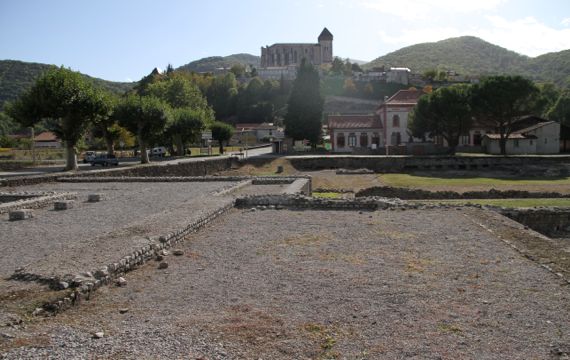
The march of time is often front/center, visually, here in the Old World. It’s there in the New World, too, but it is less obvious to the casual viewer. Here: in front, Roman foundations. On the hilltop, medieval Saint-Bertrand-de-Commings, with later buildings in between.
As we walked the more recent streets, gridded above the Roman ruins, we witnessed a kerfuffle we couldn’t quite figure out. My theory is that somebody’s cows got out and wandered the streets of the lower town…leaving deposits that made no one there happy. We saw the arrival of two aging cowherds who zipped in on bicycles carrying a stick apiece. They spoke to the woman in the truck who was quite angry? annoyed?, then gathered the small herd, and moved them on down the road to the left, then turned north, away from town. I very much like that interpretation, anyway.
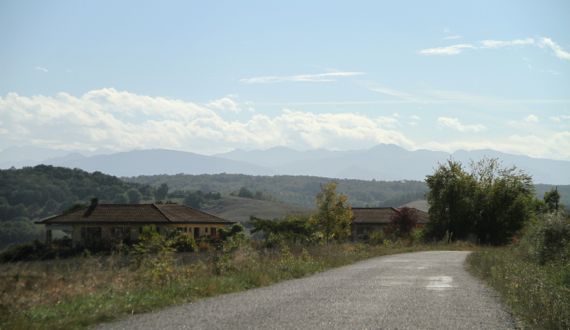
We’re now in the foothills of the Pyrenees, or were in and out of them all day. The highest ridges/peaks, when we can see them, look very rugged, often more rugged than the back row here. We will see more of the Pyrenees tomorrow.
Posted at 10:22 PM |
Comments Off on Grotte, ville, chaîne de montagne
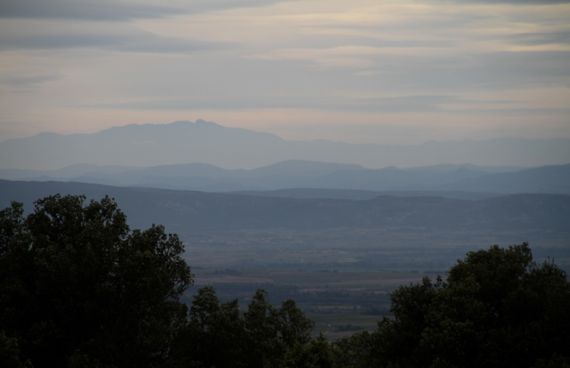
There’s a region near us, or where we’re staying now, called the Minervois, defined now as a wine region which historically was centered at Minerve. Many of the towns in this area have a version of Minerve in their names, a pattern I don’t remember from elsewhere in France. We looked in vain for a dolmen in the shrub-dominated garrigue on the ridge above town. Instead we discovered an incredible view, tinted in gorgeous shades of blue.
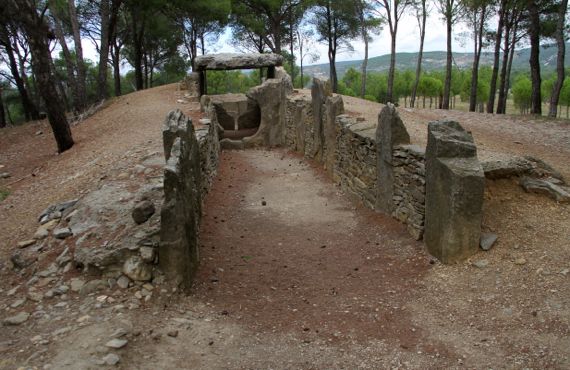
Several dolmen are known across the Minervois. This one is called Dolmen des Fades (or some variation thereof). Dolmen are, at least in the original definition, Neolithic-period megalithic tombs built across a broad swath of Europe. Seems to me that most of them are “empty” by now. We could tell there was quite a bit of reconstruction on this one, but the big stones did not appear to be from this hill. That’s a quick assessment, though.
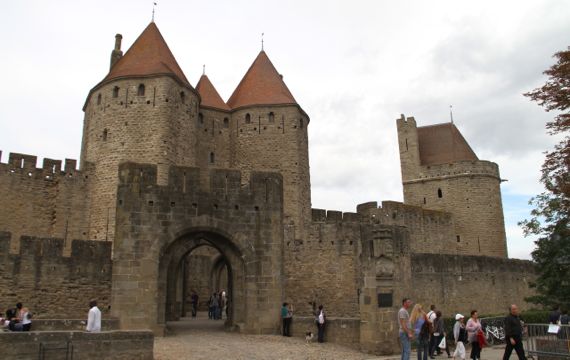
A bit later, we arrived at the east gate of the Cité, the fortified old town of Carcassonne (history in summary here and detailed here). The fortification has (at least) double walls, many towers and shooting positions, and encloses a separate fortified chateau (had a moat? now filled?)—look here (43.20731,2.36313).
I haven’t mentioned the Canal du Midi—we saw it yesterday (near Beziers first), and have been seeing it here and there as we cruise the countryside. Okay, here are the boaters at Homps, the “port” for Olonzac (our present home). The canal was built to facilitate a shipping route that avoided the Iberian coast, including the Barbary pirates.

I knew I could get us back to the political economy.
Posted at 12:26 PM |
Comments Off on Variability: Minervois, a megalith, a mega-fortification, canal
We revisited the Via Domitia. There’s a later mill immediately upstream from the remains of this structure. We saw pretty small fishies in the water, and slightly larger fishies keeping them company. Seems like there should have been even larger ones, but we didn’t see them.
This is the strangest anti-irrigation engineering feat I can remember encountering anywhere. These radiating (actually pointing inward) canals brought water to the center of this circular area, sending the flow out through a drain, making a large marshy area useful for agriculture. This was done in the…13th C. I can’t tell who masterminded this project, or who funded it.
Posted at 12:22 PM |
Comments Off on Water problems solved
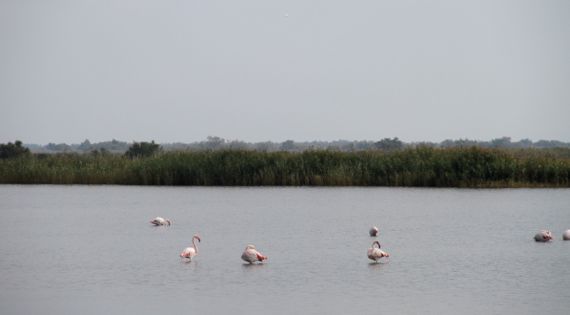
Despite a marine layer that alternately blanketed us, didn’t, and transitioned between presence/absence, we got a good look all across the delta of the Rhône between the main flow and the Petit Rhône, known as the Camargue. Lots happens here, although it seemed a bit alternately touristy and sleepy. It’s known for its white horses*, black bulls, and pink flamingos. I give you the latter. (We also saw swans, ducks, and more.) They also grow rice here, including a nice-looking red rice I’ll have to look for state-side.
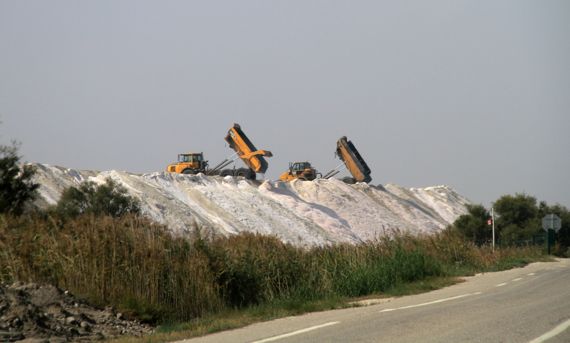
Economically, there’s of course shipping, but that passes by rather than stopping. The big resource-extraction activity here is salt recovered from the sea. We only saw this happening with large equipment; I don’t know if other methods are used. Note: those are BIG trucks; that’s a huge salt pile.
* In general, we’ve seen a higher proportion of white horses throughout southern France than I’ve seen in North America. The saddle-and-ride places have ALL white horses, no doubt selected to make the tourists happy enough to open their wallets (18 euro for 1.5 hours).
Posted at 10:22 PM |
1 Comment »
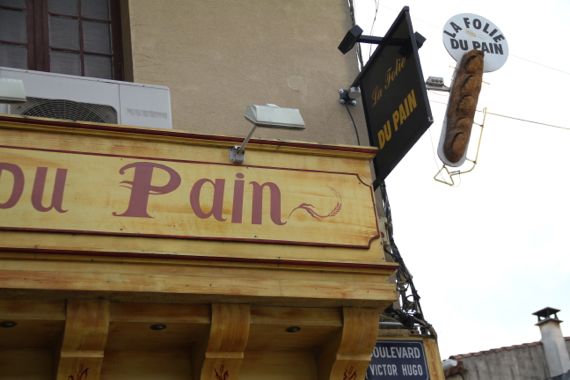
Reminder: pain in French means terrific bread; it is not painful to eat!
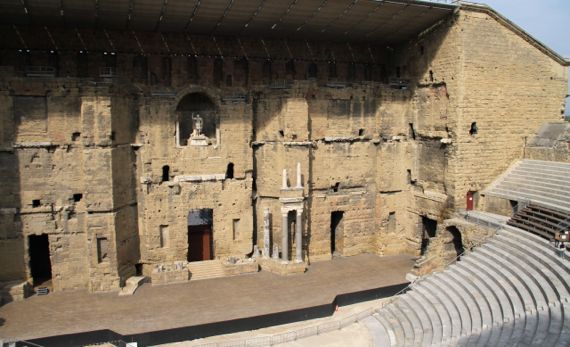
By the time this was built, estimated to be between AD 10 and 25, the Romans aimed to construct a complete architectural façade against which to stage their theatrical performances. As I understand it, the thrust of this was not only to be massive (see the tiny people to the far right of the frame) but to promote their vanquishing of this region. The formal name these days of this wonder is Théâtre antique d’Orange, and it is one of two that survive in this detail. Back in Roman days entrance was free; today you pay (that’s okay, your funds support maintenance), plus have to exit a winding trail through their junk shoppe.
Posted at 10:22 PM |
Comments Off on Of bread and…not quite circuses
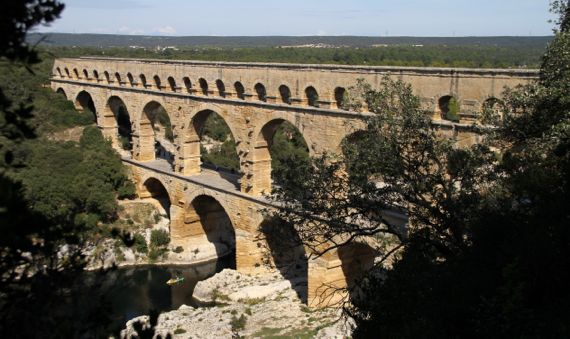
Stunning. This aqueduct, the Pont du Gard had a drop of 12.83 meters over the 50-km length of the run between the spring that fed it (we tried to get there and couldn’t—private property) and the catchment in Nîmes. The Romans of Nemausus wanted more water, and this is how they got it.
By observation, we would note that single kayaks, like this, carried quiet people, but if the kayaks passed by in clusters, yikes!—the noise.
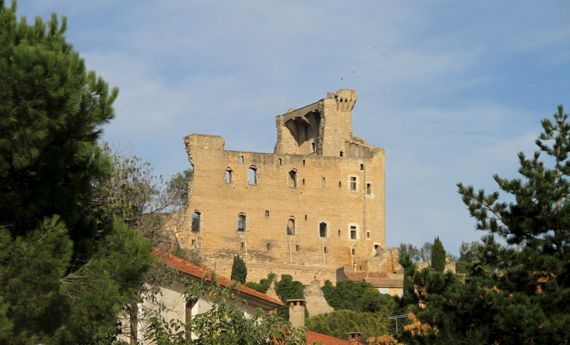
Châteauneuf-du-Pape is so named because the popes of Avignon came here back in the 1300s and developed grape-growing to have wine for their tables and to “share.” Now it is quite the wine center, with tasting places frequently encountered, both in town and along the feeder roads. The castle looming over town is a shell of its former self. The upper level has what look like machicolations that resemble those of the gothic Palais des Papes in Avignon.
Posted at 1:10 PM |
1 Comment »























